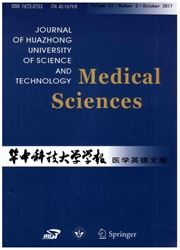

 中文摘要:
中文摘要:
目的探索脊柱手术中常见操作与医源性脊髓损伤的相关性,并提出应对策略。方法从参与单位抽取符合标准的病例作为研究组;以医院和原发疾病为配比因素,按1∶3的比例配比对照组病例。对各研究因素先后作一元及多元Logistic回归分析,找出有统计学意义者并确定其相关性。结果甲基强的松龙、神经电生理监护仪是保护因素(P〈0.05,OR〈1);椎管内使用双极电凝器、椎管内使用骨蜡或明胶海绵、控制性降压、结扎或栓塞节段动脉、三维矫形操作,块状植骨是危险因素(P〈0.05,OR〉1)。结论在脊柱手术中应尽量采取保护因素,避免危险因素,减少医源性脊髓损伤的发生。
 英文摘要:
英文摘要:
Objective To study the correlation of surgical operations in spinal surgery and iatrogenic spinal cord injury,and the corresponding solutions.Methods Cases of study group were selected from hospitals participating in the study on inclusive criteria;cases of control group were matched by 1∶3,hospitals and primary diseases were regarded as matching factors.Unary and multiple logistic regression analyses were performed to investigate factors,in order to find out factors with statistical significance.Results Methylprednisolone and neurophysiology monitoring were protective factors(P0.05,OR1);use of bipolar coagulator in spinal canal,use of bone wax or gelfoam in spinal canal,controlled hypotension,ligation or embolism of segmental arteries,three-dimensional orthopedics of spine,and massive bone graft were risk factors(P0.05,OR1).Conclusion Surgeons should take protective operations and avoid risk factors in spinal surgeries,in order to protect patients from iatrogenic spinal cord injury.
 同期刊论文项目
同期刊论文项目
 同项目期刊论文
同项目期刊论文
 Isolation and identification of cancer stem cells from human osteosarcom by serum-free three-dimensi
Isolation and identification of cancer stem cells from human osteosarcom by serum-free three-dimensi Video-Assisted Anterior Transcervical Approach for the Reduction of Irreducible Atlantoaxial Disloca
Video-Assisted Anterior Transcervical Approach for the Reduction of Irreducible Atlantoaxial Disloca 期刊信息
期刊信息
